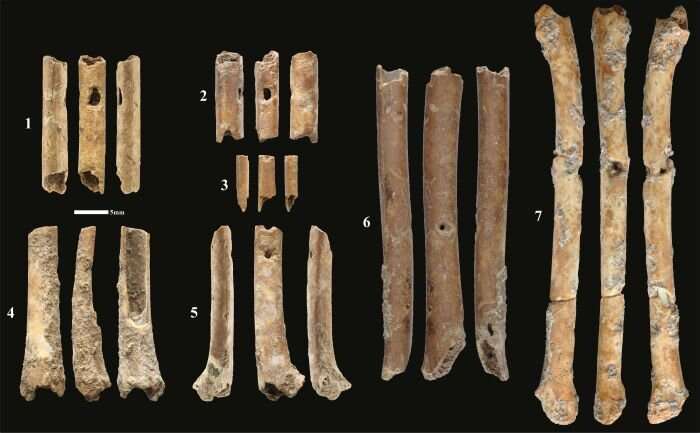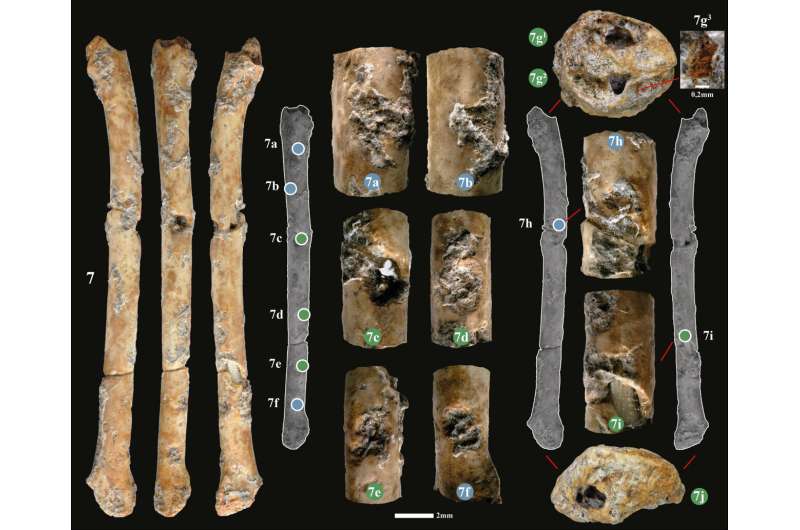This article has been reviewed according to Science X's editorial process and policies. Editors have highlighted the following attributes while ensuring the content's credibility:
fact-checked
peer-reviewed publication
trusted source
proofread
Researchers discover 12,000-year-old flutes made from bird bones

A team of researchers, including a Virginia Commonwealth University professor, has discovered rare prehistoric instruments made from the bones of birds dating back more than 12,000 years, according to findings published Friday in the journal Scientific Reports.
The seven flutes, or aerophones, found at the Eynan-Mallaha site in northern Israel belonged to the Natufians, who lived between 13000 B.C. and 9700 B.C. and were some of the last hunter-gatherers known in the Levant, or Near East region, during that time.
Tal Simmons, Ph.D., a professor in the Department of Forensic Science at VCU's College of Humanities and Sciences and a co-author of the Scientific Reports paper, identified 1,112 bones from 59 species of birds found at the site. Her research guided the team's understanding of what time of year the nomadic hunter-gatherers occupied the site and what species' bones were most frequently found there.
"Although bone 'flutes' or 'aerophones' are known from other archaeological sites elsewhere in the world, they are quite rare and have been found mostly in Europe. These are the first to ever be identified from the Near East and date to circa 12,000 years ago," Simmons said. "The flutes actually make the sounds of other birds of prey that were hunted at the site."

The discovery marks the first time a prehistoric sound instrument from the Near East has been identified, and it is the oldest that imitates a bird call from any ancient civilization.
One aerophone is fully intact, complete with finger holes and a mouthpiece. When played, the flute sounds like a raptor call—or, as Simmons said, "a high-pitched 'screeching' call, very much like a smaller bird of prey up in the treetops."
"All seven were intentionally made by grooving and rotational scraping with small stone blades into the long bones of two types of birds—the Eurasian teal and the Eurasian coot. They all show microscopic use-wear indicating they were, in fact, used or played," Simmons said. "They are also really unique because the sound they produce is very similar to that of two specific birds of prey that were hunted by the people living at the site where they were discovered, namely the kestrel and the sparrowhawk."
The researchers believe the aerophones may have been used in hunting, in communication or in music-making in spiritual practices.

"Because these are some of the earliest aerophones, it sheds light on the role of music in Natufian culture—and perhaps on the relationship of Natufian peoples with birds of prey," Simmons said.
"It may have been as a duck call—to try to lure the birds so that they could be hunted. However, it may also have been an attempt to spiritually commune or communicate with these birds of prey; they were important to Natufian—and earlier—cultures in the Levant, as seen in the disproportionate number of raptor talons in archaeological bird-bone assemblages. These may have been worn by the prehistoric people as ritual 'jewelry' and may even have been 'totem' animals."
The aerophones currently are in the zoological collections at The Hebrew University of Jerusalem on the Givat Ram campus.
More information: Laurent Davin et al, Bone aerophones from Eynan-Mallaha (Israel) indicate imitation of raptor calls by the last hunter-gatherers in the Levant, Scientific Reports (2023). DOI: 10.1038/s41598-023-35700-9
Journal information: Scientific Reports
Provided by Virginia Commonwealth University




















